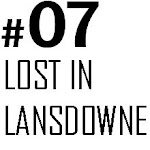The Lost in Lansdowne team have been investigating ways in which to collect information from the residents of the estate, whether they are specifically related to the main themes of navigation and identity or to their memories of the estates (both positive and negative). The following projects are several examples of creative methods used by artistic professionals.
//Encounters - The Moey, South Liverpool, 2007.
//Encounters - The Moey, South Liverpool, 2007.
The Moey was produced by Encounters and gmproducts as part of Capital of Cultures Four Corners project, a city-wide neighbourhood regeneration programme working with residents, cultural organisations and neighbourhood services. The aim of the project was to investigate the life of the communities in Liverpool, through creative engagement which would collate memories, opinions and aspirations for the future of the city.
The Moey itself was a converted police pod which travelled along a predetermined route through South Liverpool, passing through areas suchs as Garston and Woolton. At each stop, Encounters engaged passers-by regarding the themes of neighbourhoods and neighbourliness through the use of various techniques; creative writing, visual arts, photography, digital images, film making and audio technology.
//Folk Archive - Jeremy Deller and Alan Kane
Taking 7 years to put together, Folk Archive is a collection of approximately 250 images collected by Deller and Kane of what British people consider to be 'folk art' . There are photos and footage of strange festivals and competitions where life becomes performance art, including the World Gurning Championships, and a festival of insults and horse skulls in South Wales, called Mari Lwyd.
Within this project, there is a strange underlying theme of identity. What do these objects or events reveal about British-ness? What hidden stories are there to go with theses objects and could they reveal interesting information about a certain place. Could the Lost in Lansdowne group use this technique to discover Lansdowne-ness?
Within this project, there is a strange underlying theme of identity. What do these objects or events reveal about British-ness? What hidden stories are there to go with theses objects and could they reveal interesting information about a certain place. Could the Lost in Lansdowne group use this technique to discover Lansdowne-ness?










No comments:
Post a Comment